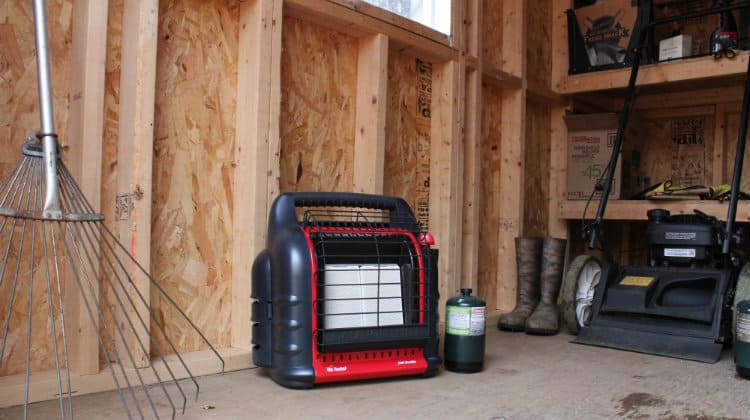Sheds have become increasingly popular as storage units, workshops, and backyard offices. Therefore, they must remain warm to protect equipment against freezing temperatures that could damage or cause discomfort for those using them.
Shed-heating options range from adding insulation to using kerosene heaters, radiant floor heating systems, and more. In this article, we’ll go over these methods of shed heating so that you can find the ideal option for your shed’s heating needs.
After reading today’s article, you can click here to learn more about mini-split heating and cooling systems.
Table of Contents
Mini-Split Systems
Mini-split systems are a great way to heat sheds efficiently. With a mini-split system, cool air enters the shed through a small unit installed on the inside wall of the shed. This unit splits the air into two streams: one stream is heated and directed back into the shed, while the other is vented outside. The mini-split system can be adjusted to introduce warm air into the shed as needed to maintain comfortable temperatures.
Mini-split systems are usually powered by electricity, making them easy to install and operate and cost-efficient for homeowners. They offer more control over indoor temperatures than traditional heating solutions like radiators or space heaters and don’t require ductwork like central HVAC systems.
Additionally, since they don’t generate excess heat in attics or crawlspaces, they’re often a better choice for smaller spaces like sheds that lack adequate ventilation.
Insulation
If you want your shed to serve more than its initial purpose of housing lawn and garden equipment or acting as workspace, insulation becomes increasingly crucial if winter temperatures drop and cold air can damage equipment or make working uncomfortable.
Insulation also ensures your shed won’t become uncomfortable to use during those long, cold workdays!
Insulation not only keeps heat within, but it also decreases moisture. Moisture damage to sheds can include rot, mold growth, and wood decay – insulation helps prevent this by slowing excessive heat transfer and limiting condensation.
Foam board insulation is an efficient insulator for sheds. Available with different R-values depending on your climate and region, seal gaps and seams during installation to keep warm air from escaping while cold air cannot enter your shed.
Ventilation
Ventilation in a shed is essential to improving air circulation and minimizing heat, moisture, and toxic chemical fume build-up, particularly when storing personal items that could become moldy or dry rot in long-term storage and expose people to toxic fumes.
Installing gable louvered vents can be an inexpensive and efficient way to ventilate a shed quickly and affordably. Still, they may not provide sufficient ventilation if your shed is too large or has a poor design.
Another option for creating the ideal shed environment is installing a cupola, which offers more decorative touches while complementing its surroundings. However, two ventilation sources must be utilized to achieve optimal ventilation balance: roof vents, exhaust fans, and gable vents.
Kerosene Heaters
Sheds have become increasingly popular as home workshops, hobby spaces, and office spaces. Unfortunately, however, most sheds do not feature adequate insulation or heating to make working comfortable when temperatures drop.
There are various methods for heating a shed without using electricity, including using kerosene heaters which work by burning combustible fuel (typically kerosene) to generate heat.
Kerosene heaters are generally safe to use and have ample heat, though they produce carbon monoxide, which can be lethal if inhaled directly. As such, leaving windows or doors open when operating a kerosene heater is always recommended. Many models even feature removable fuel tanks that can be taken outside for refilling purposes.
Radiant Floor Heating
Sheds are popularly used for storage, workshops, and backyard offices; however, most sheds lack adequate insulation or access to heat sources such as natural gas or electricity for heating needs. Therefore, insulation is an essential investment that will both increase heating efficiency and reduce energy costs in sheds.
Insulating walls alone won’t do; insulation of both floors and subfloors must also be prioritized if possible. A concrete floor may be insulated up to R-30 with insulation materials.
Geothermal or solar heating systems can be an economical way to heat a shed. They use constant temperature under the ground to heat and cool your shed during winter and summer, respectively.
Plus, many electric companies provide discounted time-of-use rates making these systems even more cost-effective! They’re easy to install and are quieter than traditional heaters!
Electric Heaters
No matter whether it is used as a workshop, home office, or garden storage shed, keeping it warm is of utmost importance. There are various heater options that will keep it cozy until temperatures start rising again come spring.
As opposed to homes, sheds tend not to have adequate insulation; thus, dense cold air can quickly absorb any heat generated and force your heater to work harder, increasing fuel or electricity costs and forcing you to work harder in producing warmth.
Compare electric heaters to their kerosene counterparts for greater safety, featuring oxygen depletion sensors and accidental tip-over switches with auto shutoff features.
Plus, electric heating solutions tend to be cheaper. Finally, following manufacturer instructions ensures safe use.











